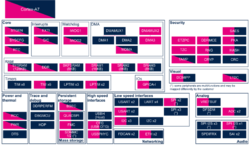1. Article purpose[edit | edit source]
The purpose of this article is to
- briefly introduce the GIC peripheral (generic interrupt controller) and its main features
- indicate the level of security supported by this hardware block
- explain how each instance can be allocated to the runtime contexts and linked to the corresponding software components
- explain, when needed, how to configure the GIC peripheral.
2. Peripheral overview[edit | edit source]
The GIC peripheral is the Arm® Cortex®-A7 interrupt controller.
It is consequently not accessible from the Arm® Cortex®-M4 core on STM32MP15x lines ![]() .
.
2.1. Features[edit | edit source]
Refer to STM32MP13 reference manuals or STM32MP15 reference manuals for the complete list of features, and to the software components, introduced below, to know which features are really implemented.
2.2. Security support[edit | edit source]
The GIC is a secure peripheral (under ETZPC control).
3. Peripheral usage and associated software[edit | edit source]
3.1. Boot time[edit | edit source]
The GIC is configured by the FSBL (see Boot chain overview), mainly to define the routing of each interrupt to the secure or non-secure context at runtime.
3.2. Runtime[edit | edit source]
3.2.1. Overview[edit | edit source]
The GIC is shared between:
- the Arm® Cortex®-A7 secure core to be used under OP-TEE with the GIC OP-TEE driver (or TF-A secure monitor if the OP-TEE is not present)
- the Arm® Cortex®-A7 non-secure core to be used under Linux® with the interrupts framework
3.2.2. Software frameworks[edit | edit source]
3.2.2.1. On STM32MP13x lines  [edit | edit source]
[edit | edit source]
| Domain | Peripheral | Software components | Comment | |
|---|---|---|---|---|
| OP-TEE | Linux | |||
| Core/Interrupts | GIC | OP-TEE GIC driver | Linux interrupt framework | |
3.2.2.2. On STM32MP15x lines  [edit | edit source]
[edit | edit source]
| Domain | Peripheral | Software components | Comment | ||
|---|---|---|---|---|---|
| OP-TEE | Linux | STM32Cube | |||
| Core/Interrupts | GIC | OP-TEE GIC driver | Linux interrupt framework | ||
3.2.3. Peripheral configuration[edit | edit source]
The configuration is applied by the firmware running in the context to which the peripheral is assigned. The configuration by itself can be performed via the STM32CubeMX tool for all internal peripherals. It can then be manually completed (especially for external peripherals) according to the information given in the corresponding software framework article.
3.2.4. Peripheral assignment[edit | edit source]
3.2.4.1. On STM32MP13x lines  [edit | edit source]
[edit | edit source]
Check boxes illustrate the possible peripheral allocations supported by STM32 MPU Embedded Software:
- ☐ means that the peripheral can be assigned (☑) to the given runtime context.
- ⬚ means that the peripheral can be assigned to the given runtime context, but this configuration is not supported in STM32 MPU Embedded Software distribution.
- ✓ is used for system peripherals that cannot be unchecked because they are statically connected in the device.
Refer to How to assign an internal peripheral to a runtime context for more information on how to assign peripherals manually or via STM32CubeMX.
The present chapter describes STMicroelectronics recommendations or choice of implementation. Additional possiblities might be described in STM32MP13 reference manuals.
| Domain | Peripheral | Runtime allocation | Comment | ||
|---|---|---|---|---|---|
| Instance | Cortex-A7 secure (OP-TEE) |
Cortex-A7 non-secure (Linux) | |||
| Core/Interrupts | GIC | GIC | ✓ | ✓ | |
3.2.4.2. On STM32MP15x lines  [edit | edit source]
[edit | edit source]
Check boxes illustrate the possible peripheral allocations supported by STM32 MPU Embedded Software:
- ☐ means that the peripheral can be assigned (☑) to the given runtime context.
- ⬚ means that the peripheral can be assigned to the given runtime context, but this configuration is not supported in STM32 MPU Embedded Software distribution.
- ✓ is used for system peripherals that cannot be unchecked because they are statically connected in the device.
Refer to How to assign an internal peripheral to a runtime context for more information on how to assign peripherals manually or via STM32CubeMX.
The present chapter describes STMicroelectronics recommendations or choice of implementation. Additional possiblities might be described in STM32MP15 reference manuals.
| Domain | Peripheral | Runtime allocation | Comment | |||
|---|---|---|---|---|---|---|
| Instance | Cortex-A7 secure (OP-TEE) |
Cortex-A7 non-secure (Linux) |
Cortex-M4 (STM32Cube) | |||
| Core/Interrupts | GIC | GIC | ✓ | ✓ | ||

